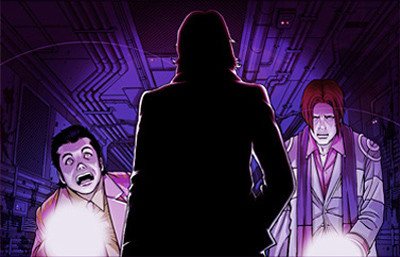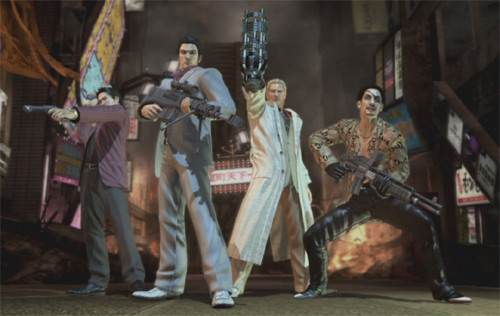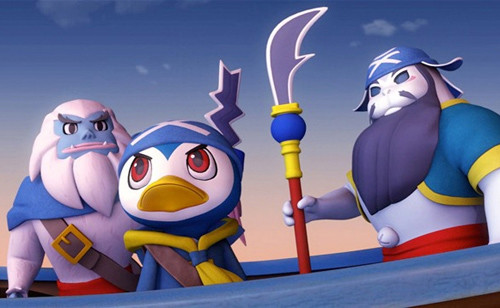- remind me tomorrow
- remind me next week
- never remind me
The X Button
Animal Collective
by Todd Ciolek,

There'll be no column next week on account of the New York Comic Con and its attendant anime festival. Fortunately, there's plenty to do in my absence. For example, you can listen to Sdatcher, the audio-drama series based on Hideo Kojima's revered adventure game Snatcher.

The first three episodes were already translated by helpful fans. The story so far follows Jean-Jack Gibson, the predecessor of Snatcher protagonist Gillian Seed. Gibson wasn't around for long in Snatcher, so it's nice to see him get his own case courtesy of Goichi “Suda 51” Suda, the crazy man behind Killer 7 and No More Heroes. The experience isn't quite the same without Snatcher's options of searching for clues or disastrously flirting with women, but I'm glad to have Snatcher back no matter how it's spelled.
NEWS
YAKUZA OF THE END COMING HERE AS DEAD SOULS
It's a fair argument that Yakuza games, with their semi-realistic simulations of Japanese gangster life, aren't crafted with the West in mind. That argument was made several times back when Sega hemmed and hawed over releasing Yakuza 3 to English-speaking audiences. Yet no one really doubted that Yakuza: Of the End would make it to North America. It's about zombies, after all, and Sega's delivering an English version under the title Yakuza: Dead Souls. That's Dead Souls, like the Joy Division song. Not Dark Souls, like the recent sadistic dungeon-hack.

Yakuza: Dead Souls drops a zombie outbreak onto the familiar series stomping ground of Kamurocho, leaving series hero Kazuma to clean it up. He's aided by longtime friend Goro Majima, Yakuza 4's Shun Akiyama, and Yakuza 2's Ryuji Goda (who gets a cybernetic minigun-arm). It's not, shall we say, the most serious of the Yakuza games, as Kazuma and company plow through hordes of undead with enough everyday weapons to fill another Dead Rising. It's out next year on the PlayStation 3, and it'll mark the fifth Yakuza game released over here, leaving only the Kenzan and Black Panther spin-offs unavailable in North America. Not bad for a series that was once thought unmarketable outside Japan.
KEIJI INAFUNE HAS TWO GAMES IN THE WORKS, ONE'S ABOUT PIRATES
Mega Man creator Keiji Inafune made some interesting news last year, first deriding the whole of the Japanese game industry and then quitting his longtime post at Capcom. Much has happened since then, including the cancellation of two Mega Man games. Inafune's founded two separate studios and worked extensively with other developers, though it was only recently that he announced a new game. A 3DS title called Kaio: King of Pirates, it's a mixture of seafaring adventure and the old Romance of the Three Kingdoms tale.

Also, all of the familiar Romance characters are now animals: dragons, monkeys, foxes, and one cute little penguin. The first trailer for the game resembles a children's cartoon from the wee hours of Sunday-morning cable, though Inafune promises that it'll tackle themes “beyond good and evil.” Publisher Marvelous has Kaio: King of Pirates scheduled for a 2012 release in Japan, with an English version rather likely.
Beyond the adventures of a penguin pirate, Inafune is helping Idea Factory with the next game in their Souls series, which includes Blazing Souls and several Spectral Souls titles. Inafune's the producer, and he's working with director Kenta Sugano (Record of Agarest War) and a lineup of character designers that includes Disgaea's Takehito Harada. Idea Factory's titles have drawn some fire in the past, though the latest Souls game at least has a memorable early title: Overwhelming Game Infinite Souls.
LEVEL-5 UNVEILS FOUR NEW GAMES IN ONE
Game compilations are normally reserved for older releases or, worse, cheap cash-ins like the Action 52. Level-5, however, plans an anthology of brand new games with some respected creators behind them. Guild 01 is an omnibus of four titles, and I'm most interested in Yasumi Matsuno's Crimson Shroud. The director's first game since joining Level-5 earlier this year, Crimson Shroud is described as a grim fantasy RPG—which also describes Vagrant Story, Final Fantasy XII, and nearly every other Matsuno game from his days at Quest and Square Enix.
The rest of the Guild 01 games show strange promise. Goichi Suda's Princess Liberation is a 3-D shooter in which the mecha-piloting teenage-girl president of Japan fends off an invasion (which summons memories of Metal Wolf Chaos). Yutaka "Yoot" Saito, creator of Sega's Seaman oddity, contributes Air Porter, a luggage-handling simulator. And Yoshiyuki Hirai of the comedy duo America Zarigani throws in Rental Bukiya de Omasse, a weapon-crafting game where players sell goods and arms to adventurers. After Retro Game Challenge, I fully support the idea of comedians creating video games, and that's one more reason to look forward to Guild 01 on the Japanese 3DS next year.
REVIEW: SOLATOROBO
 Developer: CyberConnect2
Developer: CyberConnect2
Publisher: XSEED Games
Platform: Nintendo DS
Players: 1-4
MSRP: $34.99
Solatorobo: Red the Hunter is an uncommon sort of game. It isn't so much that it's set in a world of floating islands, airships, and animal-people. And it isn't so much that CyberConnect2 wanted to make the game ever since their action-adventure Tail Concerto hit the Playstation in 1998. It's the fact that Solatorobo doesn't really care about intricate levels, steep difficulty, and other gameplay conceits that developers normally pursue. It cares more about crafting a colorful little realm for players to explore. And it succeeds there, at the very least.
Set in the next nation over from Tail Concerto's lands, Solatorobo follows one Red Savarin, a dog-man hunter who takes on increasingly odd jobs with the help of his adopted sister Chocolat and his rather Ghibli-styled mecha, the Dahak. One such job finds Red raiding a Kurvaz imperial airship, where he runs across an ancient medallion and a distant cat-woman named Elh. After a mountain-like creature attacks local towns in the Shepherd Republic, Elh recruits Red and company for a mission he doesn't entirely understand. But no matter. Red has plenty of tasks to propel him through a game full of airship battles, cat-people, dog-people, and the civilization of diverse isle-states they've built.
 Red runs across both drastic revelations and little challenges in his journey, and the resulting gameplay often comes down to grabbing and throwing things. Red's Dahak can lift everyday objects and enemies alike, catching them in mid-air for bonus strikes. It's an enjoyable technique at first, but it's Red's only method of attacking for too much of the game. Nearly every obstacle, whether it's a boss or a bug-eating plant, is bested by grabbing and tossing either projectiles or the enemy itself. And so a promising concept becomes a repetitive one.
Red runs across both drastic revelations and little challenges in his journey, and the resulting gameplay often comes down to grabbing and throwing things. Red's Dahak can lift everyday objects and enemies alike, catching them in mid-air for bonus strikes. It's an enjoyable technique at first, but it's Red's only method of attacking for too much of the game. Nearly every obstacle, whether it's a boss or a bug-eating plant, is bested by grabbing and tossing either projectiles or the enemy itself. And so a promising concept becomes a repetitive one.
Solatorobo's a simple game at heart, but it does its best to hide this with a wealth of distractions. When not plunging into the mysteries of their world, Red and his crew take on all sorts of side missions that include various temp jobs, bodyguard gigs, and bomb inspections. Some are rather enjoyable: there's a robot-battle coliseum, a racing mode that plays like an airborne version of Mario Kart, and a free-flying mission or two. Other sub-quests, however, come down to basic scavenger hunts and tedious crate-moving. It's a good deal more varied than the shallow Tail Concerto, but it's never remotely hard.
In fact, Solatorobo seems afraid of challenging the player. Red, Elh, and other characters chatter constantly throughout levels, explaining kindergarten-level puzzles and points of interest in annoying detail, as though the designers didn't trust the player to figure out how to put a red statue on a red panel, for example. On top of this, the majority of bosses are complete pushovers, mustering attacks that are easily predicated and countered by Red. Save points are plentiful, Red's health is restored often, and he's able to upgrade his Dahak with various Tetris-like parts. It all reduces the game to a sightseeing tour.

But it's a darned enjoyable tour. Solatorobo's true appeal lies in its world, in the city venues and endearing characters Red meets along his journey. Solatorobo's assembled from old-fashioned adventure tales and accessible anime charms, mixing Miyazaki's Castle in the Sky and Sherlock Hound with a decidedly French atmosphere. Each of the various islands of the Shepherd Republic has a distinct look, from a bug-filled kingdom of giant spores to a dour collection of wrecked airships. Such places are peopled with all sorts of oddball cats and dogs. They're overeager inventors, sky photo-hounds, flamboyant merchants, goofball pirates, spoiled pop stars, and reticent historians—and almost every one of them has a story to share.
The main characters carry things just as well. Red's enthusiasm is infectious, and Elh's a good, formal counterweight to him. It almost makes up for the clichés that lurk deep down. Distinguished only by the dog-and-cat characters, Solatorobo's central tale runs through the same hackneyed checklist used in countless anime-influenced games. Weapons from long-dead civilizations? Check. Fetch quests involving crystals and ancient relics? Check. A plot twist where the heroine betrays the hero and then can't understand why he still wants to rescue her? Check. A marginally risqué shower scene that's somehow important to the story? Check, I'm afraid.
 There are, however, a few surprises in store. Solatorobo feels very much like two games in one, as though CyberConnect2 didn't want to wait another ten years for Namco Bandai to greenlight a sequel. The second half of the game throws an interesting curve into the story, though any fans of popular science fiction will see it coming. More importantly, this extended coda strengthens the rather anemic combat, giving new moves to Red's arsenal and new options to his robot upgrades. There's also an all-bosses mode available after the game's end, and it finally toughens things up.
There are, however, a few surprises in store. Solatorobo feels very much like two games in one, as though CyberConnect2 didn't want to wait another ten years for Namco Bandai to greenlight a sequel. The second half of the game throws an interesting curve into the story, though any fans of popular science fiction will see it coming. More importantly, this extended coda strengthens the rather anemic combat, giving new moves to Red's arsenal and new options to his robot upgrades. There's also an all-bosses mode available after the game's end, and it finally toughens things up.
Solatorobo's mixture of 2-D and 3-D works surprisingly well on the DS screen, with beautifully detailed cityscapes and numerous little touches of animation. Major plot points get special cutscenes of polygon backgrounds and cartoonish character models, and it's aided by some stylish art from Nobuteru Yuki and an impressive soundtrack by the largely unknown Chikayo Fukuda and Seizo Nakata. Voices are limited to snippets of French, and it enhances the game's gentle humor in a way that extensive acting never would. Xseed and Nintendo of Europe's translation serves well enough, and it's even entertaining to pick out the manifold references to foods, myths, and real-world cats and dogs.
Solatorobo: Red the Hunter never quite expands as it should. It's too easy, too repetitive, and too determined to coddle the player. But it's also charming at every turn, and it unfolds a well-imagined world and likable characters over familiar storytelling. Perhaps that's not such a bad trade-off. The game industry is at no loss for blandly grim creations with well-planned gameplay, and that makes Solatorobo stand out all the more. It's not a great game, but it's a bright, happy, and ultimately enjoyable one. And sometimes that's more important.
NEXT WEEK'S RELEASES
NARUTO SHIPPUDEN: ULTIMATE NINJA IMPACT  Developer: CyberConnect2
Developer: CyberConnect2Publisher: Namco Bandai Platform: Sony PSP Players: 1-multiplayer MSRP: $39.99 Naruto may well be seen as the icon of an age by future students of Anime History, which will likely share college buildings with Hair-Metal Archeology and Reality Show Studies. Perhaps they'll argue that Naruto's rise signaled the height of the anime boom in North America, and that the industry was truly finished when Naruto fandom flickered out. If that's true, the end hasn't yet arrived: Naruto still sells manga, gets aired on cable, and gets video-game releases on a regular basis. The latest game, Naruto Shippuden: Ultimate Ninja Impact, sends the Naruto cast down a route similar to the Dynasty Warriors games, fashioning big battlefield brawls between familiar Naruto characters and hordes of enemy ninja—plus the occasional giant boss. Developer CyberConnect2's take on large-scale combat features a healthy lineup of characters; standards like Naruto, Sasuke, Gaara, Sakura, and Rock Lee are on hand, plus lesser-seen faces like Killer B, Pain, Sasori, Kakuzu, Hidan, and Deidara. The storyline covers Shippuden events up through the Five Kage Summit Arc...which seems to be a hundred chapters shy of the current Naruto plot, but we can't let games jump ahead of their inspirations here. CyberConnect2 makes generally decent Naruto fighters, and Ultimate Ninja Impact shows solid material. At the very least, it can serve someone's argument that the anime industry isn't dead just yet. |
PROFESSOR LAYTON AND THE LAST SPECTER  Developer:Level-5
Developer:Level-5Publisher: Nintendo Platform: Nintendo DS Players: 1-multiplayer MSRP: $29.99 Professor Layton and the Last Specter is laboring in the shadow of the game that fans of the series really want: the upcoming crossover of Professor Layton X Phoenix Wright. Yet there's no reason to skip The Last Specter, which sketches out of the first meeting of the professor and his sidekick Luke. In this prequel, Luke's the prophecy-plagued son of a town's mayor, and he tags along with Layton and his assistant Emmy as they investigate local stories about a monstrous apparition. As with most Layton games, uncovering secrets is a matter of solving various logic puzzles, which include block-moving challenges and code-breaking carried out with the DS stylus. Such challenges are supposedly the meat of the Layton series, though one wonders if some followers of the series are now more interested in the ongoing storylines and quaint cartoon atmosphere. The Last Specter also includes Professor Layton's London Life, a bonus RPG from developer Brownie Brown. It follows a player-created avatar through the streets of the Layton-era London, and many familiar characters from the first four Layton games show up. It's also fashioned much like an RPG from the Game Boy Advance—Mother 3, to be specific—and Level-5 promises 100 hours of play inside London Life. Such claims are best sliced into fourths, but even a 25-hour RPG makes for quite an extra. |
discuss this in the forum (13 posts) |
this article has been modified since it was originally posted; see change history